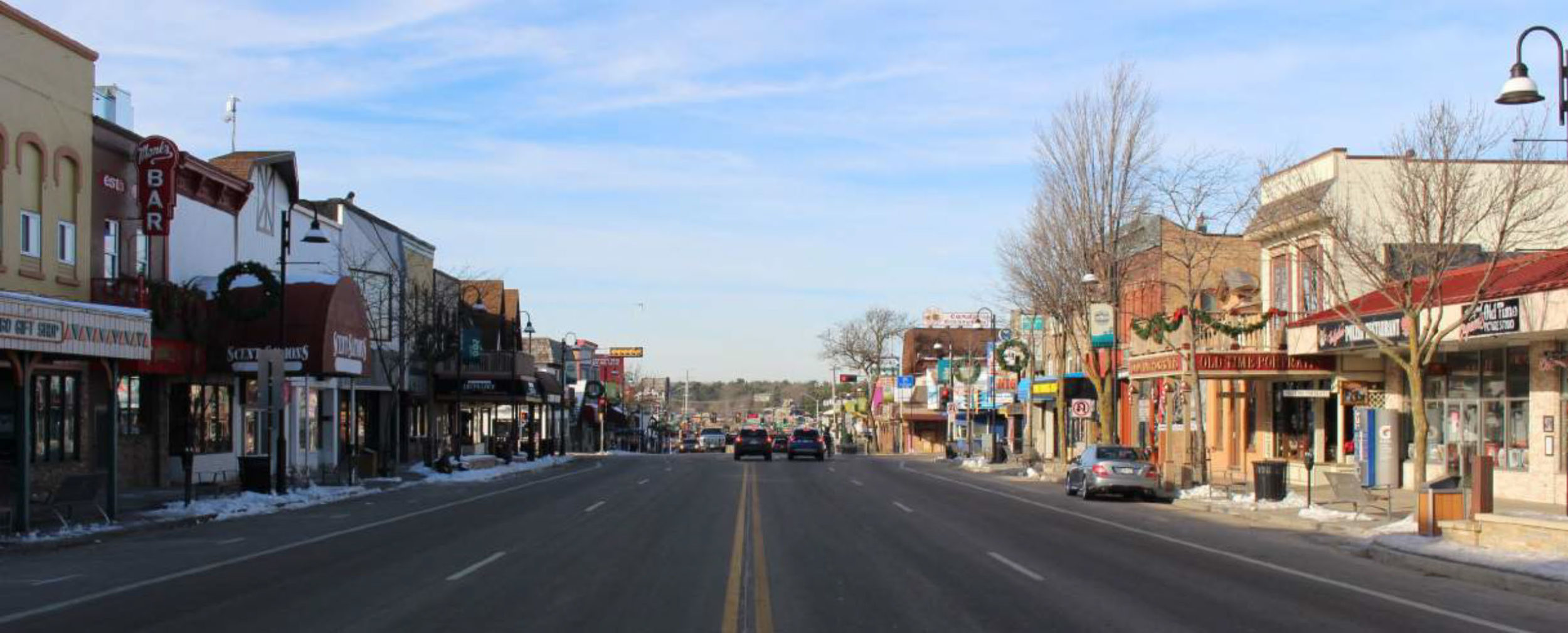
Broadway through Downtown Wisconsin Dells west to Superior Street.
Field Trip Guide (Part 2)
By Kevin Patrick
Downtown Wisconsin Dells
Downtown Wisconsin Dells is best explored on foot starting from the Milwaukee Road Depot on La Crosse Street. The depot was rebuilt in 1989 after a train derailment destroyed the original 1857 station. The Hile House was across La Crosse Street at the Wis Dells Visitor & Convention Bureau, and the Helland Hotel was on the site of Dells Bells Wedding Chapel.

Minirama was a scale model version of Wisconsin Dells complete with moving trains and boats that operated on Broadway
from 1960 to 1969. Dairyland Fudge next door was decreed the “official fudge” of the 1964-65 New York’s World’s Fair.
Stanton’s old Palm Garden and Hiawatha Bar is one block north at Broadway & La Crosse, operating as the Showboat Saloon since 1965. The 1929 Spanish Colonial Upper Dells Boat Landing is across Broadway. The Haunted Mansion on Broadway east of Eddy Street was built as the Post Card Shop in the 1920s, becoming Bennett’s Minirama from 1960 to 1969.

Nig’s Bar in the Neoclassical Kilbourn State Bankbuilding.
Nig’s Bar is in the old Neoclassical Kilbourn State Bank building at Broadway & Superior although the original “Have a swig with Nig” Normandie Bar was across Broadway at what has been Monk’s Bar since 1962. The original Monk’s opened at 173 Oak Street in 1947. The preserved H.H. Bennett Studio (1865-1998) is just east of Nig’s. A collection of postwar in-fill motels still operate north of Broadway between River Rd. and Oak St. including the Top Hat, River Road, White Rose, Parkway, and Finch.

Opened in 1907, Stanton’s Palm Garden operated as the Sweet Shop during 1920s Prohibition, then as the Hiawatha Bar, and since 1965 as the Showboat Saloon.
Vine Street Cabin Courts – Wisconsin Dells
By 1924 auto tourists could follow the blazes of the Black and Yellow Trail from Chicago through Milwaukee and Kilbourn (Wisconsin Dells) to
Yellowstone National Park via the Black Hills. Established in 1919, the Black and Yellow Trail served the territory not served by the 1912 Yellowstone Trail, which crossed Wisconsin farther north. The Black and Yellow entered Kilbourn from the southeast, north up Vine Street then west on Broadway.


Whitehouse Cottages were the less formal alternative to the Whitehouse Hotel on Capital Street before World War II. After the war a windmill was added to the office and the cabin court became the Dutch Mill Motor Court. The windmill has been lost, but the cabin court survives.
The national Federal Route system established in 1926 marked the Black and Yellow Trail as US 16 west across Wisconsin from Milwaukee following the same Vine to Broadway route through Kilbourn. As soon as tourists entered town at Spring Hill they encountered a string of Vine Street cabin courts and cottage gas stations.

Rainbow Cabin Court, Spring Hill De Luxe Bungalows, and Wolfram’s Cabins all added motel strips after World II.
Although some small motel strips were added after World War II, Vine Street was left stranded in the 1950s by the relocation of US 16 to the new bypass that allowed it to enter town over East Broadway. Although this old cabin court strip has largely reverted back to a residential neighborhood, remnants survive. Cabins and motel rooms can still be rented at Spring Hill, Dutch Mill and Rainbow, and buildings still stand at Wolfram’s, Aztec, Drew’s, and the Komfort Kabin Kourt where – amazingly– the Shell “Wee Hoose” has survived.

The Komfort Kabin Kourt’s “Wee Hoose” Shell station still stands at Vine Street and Washington Avenue.
East Broadway Motel Strip – Wisconsin Dells
The East Broadway Motel Strip was grafted onto Wisconsin Dells in the 1950s when the opening of the east side bypass relocated US 16 to Broadway from Vine Street. There was precedent before World War II when houses along Broadway were converted into tourist homes and larger properties on the east edge of town added cabins.


TOP: Fitzgerald’s Modern Rooms at 501 Broadway was a tourist home replaced the two-block, two-story Fitzgerald Motel.
BOTTOM: At the time of this 1927 photo, Black Oak Cottages was operating just east of the Schofield Hotel. The house still stands squeezed between the Indian Trail Motel and Amber’s Hideaway.

The Blackhawk Cottage Court at Broadway & Race Street has been converted into a motel court (above); and The Frozen Bear at Broadway & Elm Street operates out of an old Pure Oil gas station.
After World War II, Modernist motel blocks with built-in swimming pools heralded by neon metal box signs replaced or crowded out the older treeshaded cabin courts.

Colonel Robert Schofield was another Civil War veteran who lived out his life in Wisconsin Dells after the war. In 1883 he opened the Schofield Cottage Hotel on the east edge of town where these auto tourists were photographed in 1929 (left). Motel blocks and a swimming pool were added in the 1950s and 1960s when the name was changed to the Indian Trail Motel.

